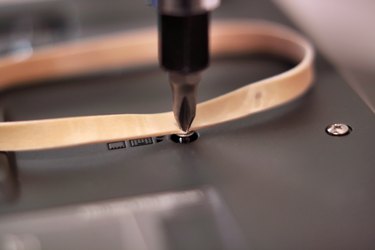
Laptop screws are often fine with small heads that require a specific screwdriver size. If the screw is overtightened or the screwdriver is the wrong size, the head can strip, leaving no way to control and turn the screw. This is a serious nuisance, and removing the screw is not always an easy task. A variety of different methods can help to regain control and remove a stripped screw from laptops.
Switch Screwdriver Size
Video of the Day
Stop attempting to remove the screw the moment it begins to strip. Laptop screws are soft, and the situation can become worse in a hurry. After stopping, switch to a slightly larger screwdriver. The larger screwdriver might grab the head firmly and remove the screw.
Video of the Day
If the larger screwdriver fails, change from a Phillips head to a flathead style. When a screw strips, the indentations no longer fit exactly, and switching to a simpler screwdriver can help gain a grip on the head. Play with different sizes until the screwdriver grabs and turns the head.
If this process fails, the screw is likely fully stripped, and a screwdriver alone is not the likely solution. Additional measures are required to grip the screw enough to turn it. A few turns are often all that is necessary to expose enough of the head to grip and remove it with pliers.
Use Pliers
Most laptop screws are recessed and are difficult to grip with pliers. Use the finest needle nose pliers you can find to grip the screw. Ideally, a small portion of the head is exposed, and you can grip the entire head to turn the screw to the left. Sometimes, gaining a grip by inserting one nose into the slot where the screwdriver normally goes and another along the edge of the head is adequate.
Use a light grip with the pliers to prevent further damaging or breaking the screw. These delicate screws cannot handle the same pressure as a typical wood or metal screws. Use some finesse and continue turning the screw until it's completely removed.
Try a Rubber Band
A rubber band can fill the stripped gaps and provide grip for a screwdriver. Cut a rubber band with scissors and lay it flat on the screw head. Press the screwdriver into the screw and use pressure while turning to get a grip and twist the screw. The screwdriver compresses the rubber band and improves the grip on the screw.
If the screw is completely stripped, the rubber band does not have any slots to fill, and this method may not work. However, it is worth attempting and may provide a few turns to loosen the screw. Once the screw is loosened, the remainder of the job is easily completed with pliers.
Drill It Out
Drilling out the screw is the last resort. Drilling out screws is not a big deal in most cases, but laptop screws are small, and drilling can permanently damage the threads. Drilling is difficult because you must find a drill bit that is slightly smaller than the screw size.
Choose a metal bit and first drill at a shallow depth. The idea here is to make a small impression on the screw head. Now attempt to remove the screw with a screwdriver. Repeat the rubber band method if necessary as well. The new divot may provide enough traction to grip and twist the screw.
If the screw head does not provide grip after drilling, carefully drill out the entire screw. Drilling is rarely necessary, and excellent control is required to prevent widening the screw hole. Be careful and completely remove the screw before inserting a replacement.